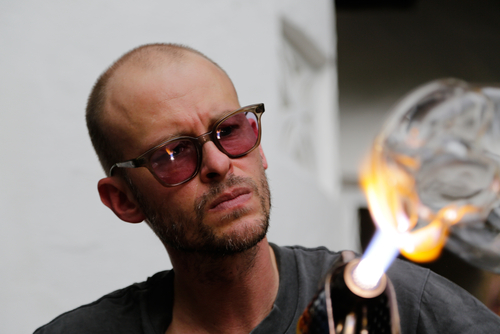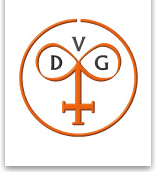VDG-Nachrichten 04/2023
DIMENSIONISM
Glass Dress Project

Bernd Weinmayer does not shy away from any challenge, whether it be a technical engineering project or a work of creative artistry.
He has already contributed two articles to our specialist journal. In issue 2/2020 he wrote “the art of technical apparatus", reporting on his rocky and adventurous path to independence and his realisation that corona does not necessarily mean doom. And then in issue 3/2020, he shared with us his interest in his favourite devices, materials and tricks of his trade that no good glassblowing workshop should be without, including woven stainless steel and its potential applications.
In this issue, he inevitably returns to the period during the pandemic, when at times the corona virus itself seemed to be the least of the issues. It's hard to imagine the challenges that specialist craftspeople were confronted with at that time. The miracles can be achieved with our wonderful material are revealed in Bernd’s latest fascinating article.
On finishing the interesting ‘Face Mask Project’ in 2019, I thanked my client Iris van Herpen and said goodbye with the flippant words, "If we ever get bored, we'll just make a dress out of glass!" At that point in time, no-one could have guessed what would happen just one year later, when order books were standing empty and even loyal customers had to put their business on hold, all due to the pandemic.
Iris van Herpen is a world-famous haute couture fashion designer from the Netherlands. In 2012, she celebrated her international breakthrough with the 3D printed "Bone Dress" and since then she has been a permanent fixture at Paris Fashion Week. Van Herpen's work is unmistakably bombastic yet feminine.
When I saw the ‘Bone Dress’ for the first time, I immediately imagined this extravagant three-dimensional structure in glass - perhaps hollow, filled with my neon plasma light technology?
The decision: yes, we can
So I reached out to Iris to ask whether she would indeed be interested in an adventure like that, and, to my great surprise, she quickly gave me a positive response. I showed her some pictures of my work: structural patterns and the rough outlines of what can or can’t be done with our lamp glass technique. Then, out of the blue one Sunday afternoon, I received a new design by email - a kind of ‘Bone Dress 2.0’ which was later to be renamed "Dimensionism”. Iris had created a design especially for this glass dress project! Looking at the design study for the first time almost brought tears to my eyes. I had never in my wildest dreams expected such a delicate, almost elfish structure – let alone one that actually seemed realisable - just. In my naive enthusiasm, I replied to her email the very next day, saying as "I can do it, no problem." And thus the project, which was to take me 6 months to complete, got off the drawing board.
Communication between us happened via Skype. Communication is not really one of my strengths at the best of times, but over a video link, on the subject of feminine fashion, and then in minimalist English… pure stress for me! However, Iris and I are united by our creative approach to a project and our focus on our respective strengths. Questions about financial viability, later utilisation options, ownership etc. which could distract from the topic at hand didn’t feature during the entire creative phase. In addition, there were absolutely no deadlines for the realisation schedule at the beginning, as we were both conscious that this project was genuinely breaking new ground.
Getting started
The first step was the conversion from a two-dimensional design to a three-dimensional paper model. Actually, not truly three-dimensional, because we just stuck the front, back and two side views onto a mouldable plastic dress. It was a simple solution, but surprisingly functional as a silhouette mould.
Exact measurements couldn’t be extracted from the paper model, due to the structural design being very intensely interwoven; it was impossible to reproduce this 3D structure precisely enough on paper. Fortunately, my three-dimensional imagination and sense of proportion are among my greatest strengths.
As with other major projects of mine, it took me several days to think about the production process and its timing. Once a project has taken shape in my imagination, then I am ready and able to begin production. The dress consists of countless individual parts that are fused together to form first smaller and then larger segments. These segment parts are easy to finish on a table-top burner and can be very detailed. Joining two such parts together in a repeated process allows larger and larger segment parts to be formed, although at some point these can only be worked on in a very restricted manner, usually whilst standing with hand torches.
Liquid glass always moves downwards under the influence of gravity. Rotating an object allows uniform wall thicknesses and visually flowing structures to be achieved. Parts then have to be fused together without moving the individual sections, as they are too bulky and already weigh up to several kilos. There is a high danger that any incorrectly processed connection points will break due to thermal or mechanical stress, and also a risk of condensation, which forms immediately in the openings with flame contact on the inside and could flow onto a hot spot if the position is changed.
The next challenge.
The dress actually had to fit a model’s body and be wearable. The design is off-the-shoulder and the whole dress rests solely on the two hip bones. In order to achieve this and to tailor the dress exactly, a heat-resistant torso had to be constructed with the precise measurements. Petra, Iris's assistant, gave me the specifications and I went in search of a metal mannequin. Without success.
Stefan Andrä from Grafittechnik Andrä: my saviour
In the end, Stefan Andrä produced a 1:1 model torso from a 165kg graphite block using a digital body scan. The resolution of the scan was not high enough and so Stefan and his colleague Detlef Langner had to put in a weekend shift to smooth out the milling gradations by hand. By now it was the beginning of October and I needed the graphite torso urgently. Without further ado, Stefan personally drove the graphite model from llmenau to me. Well, almost. We were in total lockdown at the time and so Stefan and I arranged to meet at the old state border in Kiefersfelden. We parked our cars 100 metres apart from each other and the torso, wrapped in a cloth, was handed over right on the border.
Stefan's work was perfect. The torso was extremely mobile and flexible when mounted on a trolley. Now I was finally able to adapt the body-fitting parts directly to the graphite structure with my 2,000°C hot hand torch flame.
After just two months, Iris was able to get a sense of how the project was progressing, thanks to regularly sent segments (mostly in digital image form, but also once as a haptic glass segment sample to touch). Iris is a positive, enthusiastic person, but of course she can also be very critical, demanding the best from herself, her employees and her project partners.





Under time pressure
In September, I was informed that the dress was to be shown at the Iris van Herpen spring collection of the Paris Fashion Week in early February 2021! This was an honour, of course, but it was the first time that I had been put under time pressure in this project. So far, I had only produced dress segments and none of them had been in contact with a real person.
The dress is made of both hollow and solid glass structures, which are rarely round in cross-section. In some cases, flat, thick-walled pieces of flat glass had to be melted into the tube radii. This was particularly necessary for the pompous dress loops. The difficulty with structurally moulded glass is the short working time of borosilicate glass. There are only a few seconds to draw a tubular structure, sometimes 50cm long, without tools and at the same time bend it into the correct curve. These were needed on both the left and right sides, and the front and back had to be mirror-inverted. In reality, countless individual parts were produced for my dress, probably enough for a total of 3 dresses. Around 15kg of glass ended up in the rubbish bin – singletons without any matching mirror pieces.



Production running at full speed
A documentary film of the process
The Skype conversations with Amsterdam had now become an almost daily routine. Iris wanted to capture the final production process in a typical process film and sent a two-person film crew to Mariastein. Easier said than done, as we were still in lockdown. Entry to Austria was only permitted under certain work-related conditions and accommodation had been closed throughout Tirol. Filmmaker Jip Mus and his assistant Rollo van Wijk nevertheless travelled to Tirol at their own risk and spent several days in an abandoned guesthouse in my village of Mariastein, where they were allowed to use the large catering kitchen to prepare their own meals. An impressive process film was made in mid-December 2020, which shows me producing the small insert element for closing the back opening -
Youtube: https://www.youtube.com/watch?v=idYXG_tJiKU
In the film, the dress still consists of the two large individual parts, which were then fused together at the end of December. A major challenge was to link the large, detailed segment parts in such a way that it would be almost impossible for even a trained eye to see these connecting lines.

Tempering processes bring major concerns
When I look back, one major problem that I hadn’t initially thought about stands out. With each of the countless annealing processes, the structure was sitting down more and more due to its increasing weight, which by the end was 7kg. This was causing the dress skirt to become both shorter but wider. In fact, this ratio shifted by almost 5cm – a detail which did not go unnoticed by Iris van Herpen. Two weeks before the collection date, I was told that I had to lengthen the dress by approx. 5-10cm. Impossible! To achieve it, the flame would have had to intervene in already finished sections. And so I had yet one more of the countless nights of crisis during the project.
Gas filling ensures a dazzling appearance
About 10 days before the deadline, the glass dress was finally ready and I could start with the inert gas filling. Due to the complex shape structure, with countless sub-areas and only one electrode, my recommendation was a xenon/neon mixture in red/orange/blue/violet colours. This is light-intensive and therefore easily visible in the dark and can also be switched on with a low current during the model presentation on the catwalk. The basic requirement for this was a skin-tight, transparent silicone body so that there was no direct contact between skin and glass.
Iris opted instead for an exotic green/blue northern lights colour fog. This could be realised with a neon/xenon/nitrogen mixture, but the side effect was that considerably more power was required for this gas mixture, potentially posing a danger to the model. The key feature of this multicolour mist mixture is the light manipulation by the person wearing it. For example, if the model touches the light-conducting glass parts, the light is not only attracted and intensified by the hand contact, but the colour tone also changes.
A special detail for neon specialists: the small, removable back piece is also filled with an identical gas mixture. Although it has no cable contact and therefore no direct power supply, this segment lights up in the same blue-green colour tones when inserted. The large electromagnetic field, or more simply the electrosmog in the immediate vicinity of the dress, makes this wireless induction power supply possible.
Right on schedule, the dress was professionally packed, collected from Mariastein, and sent to Amsterdam. And then, on the same day, I received news that the dress would no longer be part of the upcoming haute couture collection. The reason given was that in the first online show, viewers might think that the magical plasma light was artificially created and not real.



Afro-Albino supermodel Diandra Forrest gets dressed in the dress
The dress comes to life
Too bad - but the dress was filmed in 2022 in a high-end production, worn by the wonderful Afro-Albino supermodel Diandra Forrest, and perfectly staged photographically. As the film team decided to have the model emerge from a water bath wearing a glass dress, the plasma light effect could not be used at the same time. It would simply have been too dangerous. So the effect was added later and presented for the first time in autumn 2023.
For the next 4 years, the dress will be on a world tour together with Iris van Herpen's most famous works. This very special fashion show will start on 28 November 2023 in Paris, followed by Brisbane, Singapore and Rotterdam. More detailed information about locations and dates will be announced on my website.
The question of all questions
Does the world really need a ball gown made of glass? The quick answer is: of course not. With its 6,000 volts, 50,000 hertz and 7kg super-fine glass structure, this creation is a life-threatening fashion idiosyncrasy.
But for me as a professional glassblower, such bombastic commissions make far more sense. In all respects, it is a groundbreaking project that yielded countless insights which can be infinitely helpful for further work. I was pushing the boundaries in terms of glass size, glass tension, bending tensile strength and elasticity of such a large structure. How does plasma neon light behave with only one electrode input hidden on the back of the dress? Would the neon light split symmetrically and really light up the entire piece? How do I as a person behave with the countless highs, lows and extreme pressure situations? On that note, I would like to thank my family in particular for letting me stay in my tunnel vision world as best they could during this time. How fair and empathetic is the behaviour of the design team? How would my regular customers react, some of whom received their ordered glass months late? I informed my most important customers about this priority work project right from the start. Fortunately, there was a great deal of understanding - some of them were really excited and enquired about the progress of the work – although whether out of genuine interest in the dress project or more pragmatically to find out when "normal" glass appliances would finally be manufactured again remains to be seen!
Ultimately, however, my personal motivation is to create real glass full of magic and enchantment using traditional craftsmanship - something that artificial intelligence can only dream of, if it could only dream at all.

VDG-Nachrichten
Herausgeber
Verband Deutscher Glasbläser e.V., Karlstr. 7, D-48268 Greven
Erscheinungsweise
vierteljährlich im März, Juni, September und Dezember (Sonderausgabe nach Bedarf)
Format
210 x 297 mm (DIN A 4)
Bezugspreis
Der Mitgliedsbeitrag beinhaltet den Bezug der VDG-Nachrichten; Bezugspreis für Nichtmitglieder: 13,50 €.
Druck
Karl Elser Druck GmbH, Mühlhacker / E-Mail: info@elserdruck.de
Kontakt, Anfragen und Anzeigenschaltung:
Redaktion des VDG e.V.
c/o Eberhard Karls Universität Tübungen
CZI Glasbläserei
Karin Rein und Thomas Nieß
Auf der Morgenstelle 6
72076 Tübingen

